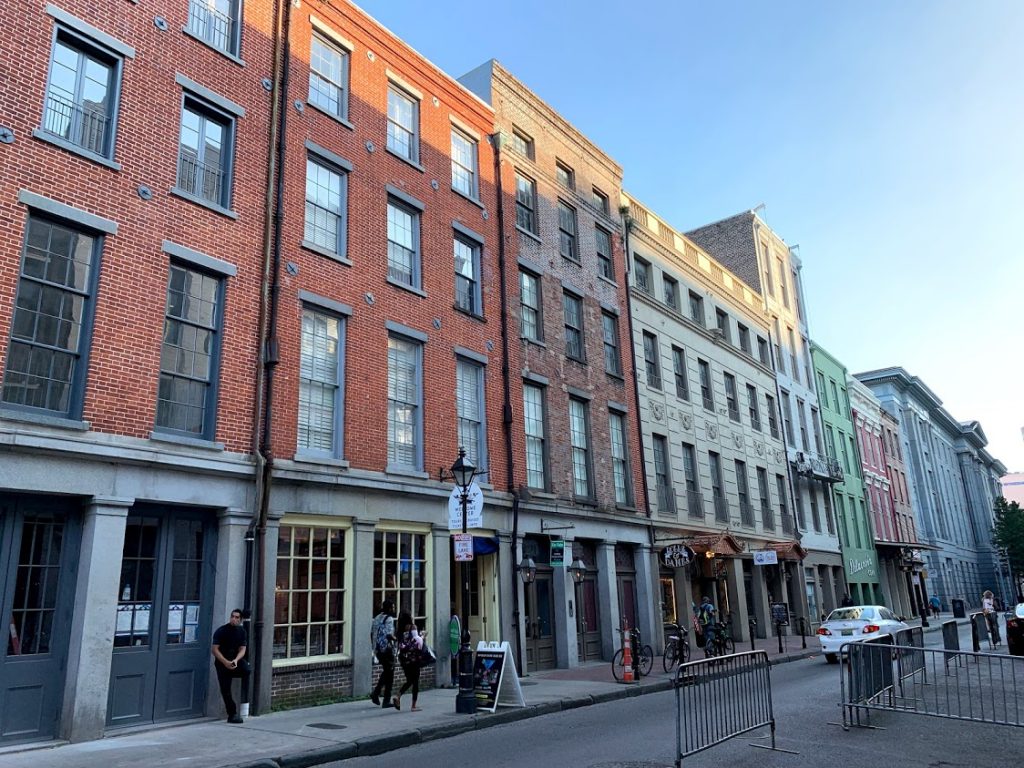
A French Quarter sunrise. Photo by Sabrina LeBoeuf
On August 28, 2005, I was a little girl sitting in the back seat for the longest road trip of my life. Normally it would be a nine-hour drive from Slidell, Louisiana, to Austin, Texas, but seeing as how everyone else in Louisiana was evacuating the area, an extra three hours were tacked on. That was our punishment for waiting to leave until the day before Hurricane Katrina hit.
We were heading for the refuge of my cousin’s house on the edge of Round Rock. Once we pulled into the driveway that evening, my mom, sister, and I set up camp in the bedroom at the far end of the hall, while my dad promptly turned around and headed back to Louisiana for his job. Stuck in Texas, we waited one month for the day we could return home.
Everyone seemed to be more worried than me. I was only in first grade and too young to understand the gravity of the news reports my mom watched on TV. I was comfortably distracted by the neighborhood ice cream truck and my temporary new school, where I got to learn the multiplication tables before all my friends back home at Bonne Ecole Elementary and ditch my dreaded red and navy uniform.
We eventually made it back to Slidell, but in 2011 we moved to Texas permanently. My dad got a new job in Plano, and in 2017 I started college in Austin, where I remain today. Soon after, my mom, freshly divorced from by dad, moved nearby. I’ve been in Texas for almost 10 years now, and whenever I’m standing in my mom’s apartment bathroom, looking in the mirror decorated with Mardi Gras beads and a copycat Blue Dog painting hanging in the reflection, I can see a lot has changed since that young girl left Louisiana for good.
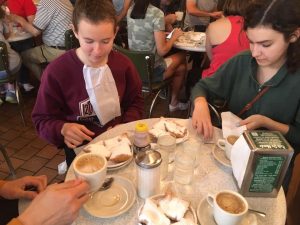
I had to borrow my sister’s green sweater for this trip to New Orleans because I own too many Texas shirts. Photo courtesy of Tommy LeBoeuf
For starters, there’s no storm keeping me here. I stand on Texas soil by my own will. I say “yeehaw” more than I say “How’s ya’ mom‘n’em?” like my Maw Maw does. (Maw Maw is Cajun for grandmother.) I own a Texas-scented candle, and instead of going to Rouses to get my King Cake, I have my Maw Maw send it to me through the mail. I also wear burnt orange more than I wear my spare purple and gold LSU shirt. This new wardrobe makes it a struggle to pack for trips to Louisiana because if I wear anything that screams “Texas,” I’ll get eaten alive.
To any stranger, I pass for a bona fide Texan, but on the inside things are a little murkier. When people ask me where I’m from, the answer varies between Slidell, Plano, and Austin. It’s not easy to succinctly explain that I spent half my life in Louisiana and another half in Texas. I’m still figuring out how to reason my multifaceted identity. After all, both places have created the person I make faces at in the morning when I brush my teeth.
I am surely not the only one who feels this way. Many of my fellow Cajuns have mirrored my path. Over the past 15 years, there has been a steady migration from Cajun Country to the Lone Star State. It all started with Katrina. Our family was lucky; water only reached the doorstep of our house, and our minimal losses allowed us to return home. But those closer to the water and most everyone south of Lake Pontchartrain, the deep blue lake that separates Slidell and the Northshore from New Orleans, suffered insurmountable losses.
In total, there was $161 billion in damage and more than 1,800 deaths. When the storm hit, roughly 250,000 people fled to Houston’s Harris County, and the Astrodome filled with displaced families. About 100,000 people decided to give up parishes altogether and make the county their new home. Overall, New Orleans lost more than half of its population.
I don’t know the struggle of losing my home to a natural disaster, and perhaps out of guilt I sought out someone who did so I could learn more. This summer, that led me to Erin Legier, a New Orleans native who was forced to relocate to Texas because of Katrina. His story proved heartbreaking yet inspiring.
After assessing the damage from the hurricane, Legier and his family, and about 50 other families from his church community, made the move to Texas. They originally went to Lumberton, near Beaumont, and decided to make this new place their home. But Hurricane Rita soon hit that area, and the group was left to find a new home once again. They hopped through various Texas towns until settling in Marble Falls.
Legier and his church family greeted the move with acceptance and gratitude. To say thank you to the community for accepting them as newcomers, Legier says they shared gumbo, crawfish étouffée, and other New Orleans-style food with their new neighbors. The Texans liked the food so much that Legier created The Real New Orleans Style Restaurant to continue sharing his cooking with the community. It’s amazing how the simple act of breaking bread can bring people together.
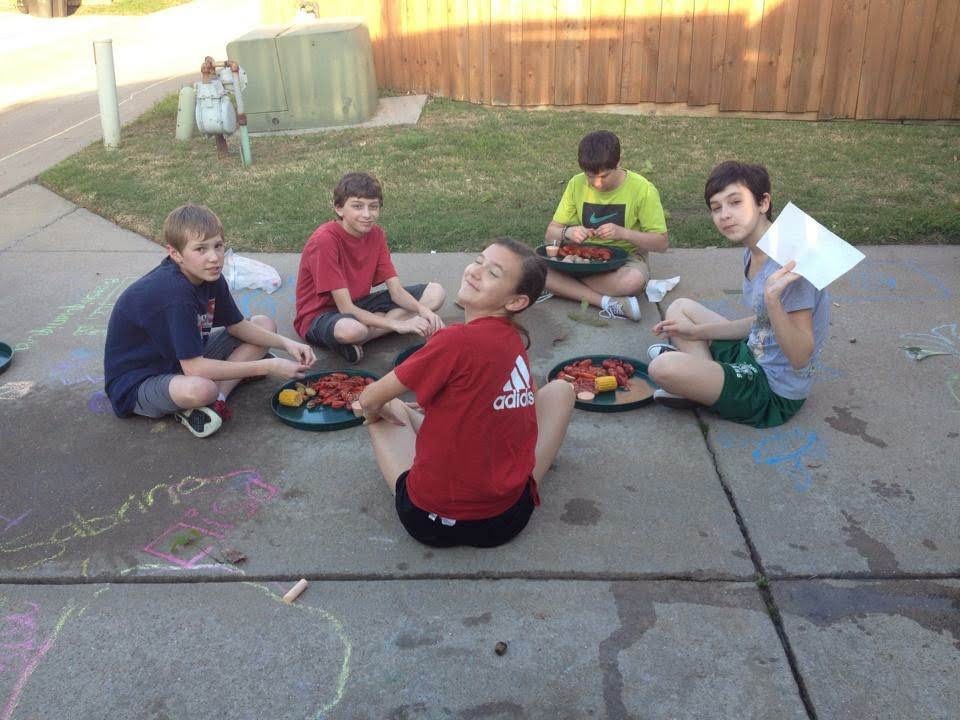
Eating boiled crawfish with family friends in Allen, Texas. Photo courtesy of Tommy LeBoeuf
After our stay in Round Rock, I went back home to Slidell and watched the rebuilding of southeast Louisiana. Many Louisianans moved to my hometown on the Northshore, increasing the population by almost one-third. The Audubon Aquarium of the Americas in New Orleans didn’t reopen until nine months after the hurricane, meaning I wouldn’t go on my school field trip until the following year, in second grade. For the places that never opened their doors again, the song “Ain’t Dere No More” by Benny Grunch & the Bunch brought a sense of lightheartedness to the loss we all knew and felt. My dad often played it during car rides.
I resumed life as a normal Cajun gal. My sister and I would get snowballs in the summer, and each December we’d sing “The 12 Yats of Christmas.” It’s another tune by Benny Grunch & the Bunch, where a partridge in a pear tree is traded for a crawfish caught in Arabi (a suburb in St. Bernard Parish) and six geese a laying becomes a six-pack of Dixie. For the longest time, my sister and I didn’t realize we were welcoming the Christmas holidays by singing about beer. All we knew was that it was tradition for Cajuns to season songs and stories with our culture and a dose of humor. You could say we are pretty proud people.
I watched the Saints play their way to their first Super Bowl win. I attended Mardi Gras parades and marched in a few of them. On the weekends, I’d go catch crabs in the bayou with my dad, or my family would drive down to New Orleans to walk around the French Quarter or Audubon Park. And we ate seafood. Lots of it.
My mom, a Panamanian immigrant who came to Louisiana in the ’90s, always told me that people who are born in Louisiana never leave. Her theory is based on my dad’s side of the family, who never dreamed of life beyond the state. My Maw Maw still meets with her high school girlfriends on a regular basis. I thought this—catching crabs and living in a place where people call “sno-cones” by their proper name—would be the basis for my life to come.
Then, like Legier, I found my way to Texas. When my family moved to Plano, we were surprised to find we knew several faces in the area. They were people my dad grew up with in Houma, Louisiana. But it makes sense. Thousands of Louisiana natives continue to move to Texas each year, regardless of if the weather is behaving. Texas is a land of opportunity. It’s so chock-full of jobs that my dad was able to secure a position with a second company and later start his own consulting business. Also, the schools were definitely an upgrade. The pace of learning felt accelerated, and more classes were available for me to take. An added bonus: There weren’t any Slidell Junior High green and khaki uniform requirements.
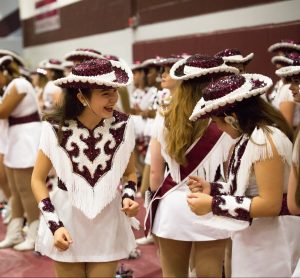
My last homecoming pep rally. Photo by Stan Scott
But I didn’t have Legier’s graceful acceptance about my new situation. I was curious about Texas, sure, yet I missed my friends, my community, my traditions. At the beginning, I couldn’t comprehend how people could just leave Louisiana, especially on their own accord. And then I met Curtis Clarke, the owner of Evangeline Cafe in Austin. He told me he always knew he wanted to be a cowboy and move to Texas. He made that dream come true when he crossed the state line back in 1991, following an epiphany during a visit to Austin in the ’80s. Austin has that way about it, and Clarke’s not the only one who’s fallen under its spell.
Texas dreams didn’t lasso me in until around high school. At Plano Senior High School, I joined the drill team, which is Texan for dance team. It’s a Texas invention created by Gussie Nell Davis, where women willingly kick their legs to their noses and jump into splits—all while wearing white cowgirl boots. I took up the tradition and wore fringed outfits and a sequined cowgirl hat most every Friday night. Eventually, I traded in my tiger dreams for Longhorn love, and I started wearing cowgirl boots at Darrell K Royal–Texas Memorial Stadium every Saturday in the fall. Yeehaw.
We all had different journeys—Legier, my dad’s childhood friends, Clarke, and I—but we all wound up in the same place after all these years. We share that and a few more things in common. None of us have plans to move back. Our lives are here now, and Texas is our home. We’ve adopted bits and pieces of the state and its culture, whether it be the quiet of the Hill Country or the thrill of the rodeo. Legier finds that he eats more tacos now, too.
It’s hard not to strongly identify with the Lone Star State. Texas took me in during my teenage years, and it sculpted me into who I am today—albeit as much as the place that gave me my family name. For me, this dual sense of pride is a funny similarity Cajuns and Texans share. They may not take pride in the same place, but they sure as hell are proud.
I notice more similarities between the two states the more I assimilate into my surroundings. There are whispers of Louisiana in the trees that line the streets of Austin’s Hyde Park. The way the branches meet and intertwine in the middle reminds me of car rides through the Garden District in New Orleans. Now that restaurants can sell alcoholic drinks to go, I’m taken back to the drive-thru daquiri spots my parents used to frequent. These resurfaced memories conjure a feeling that’s comparable to finding a lost photograph you forgot you ever took.
There are times when we transplanted Cajuns miss where we came from, or the people we left behind. Legier and Clarke miss their mothers, who still live in Louisiana. I miss my grandparents, godparents, cousins, and the rest of my family, who never left where they grew up. I wish I could celebrate Mardi Gras as much as I used to and live near more natural bodies of water.
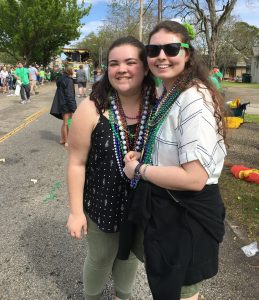
I took my two Texan friends to Louisiana to see what a real St. Patrick’s Day parade looks like. Photo by Sabrina LeBoeuf
When we crave home, we cook. Clarke told me there were times when he would fix a pot of red beans and rice, and eat that for a week straight. I started doing the same thing when I moved into my first apartment. And the food is never for us alone. As per Cajun tradition, we have to share.
“We tend to love hard,” Legier says. “That’s why the Southern comfort food came into play because you can go to anybody’s house and get a meal, and the door was always open. And that part of me never left.”
Legier and Clarke share their Cajun cooking through their restaurants. When my dad makes gumbo, he invites friends over to try it. Every time I get my King Cake, I ration it out and deliver it to everyone I know, especially those who have never tried it.
I know I’m not as Cajun as my family down by the bayou—I’ve recited the Texas pledge one too many times in school—but I’m learning to be all right with that. I will unapologetically beg my Maw Maw to come see a rodeo and continue to share Cajun flavor with my Texas community through food and stories. It’s about time I accept this Texas-Cajun face in the mirror. The word home can mean more than one place.








